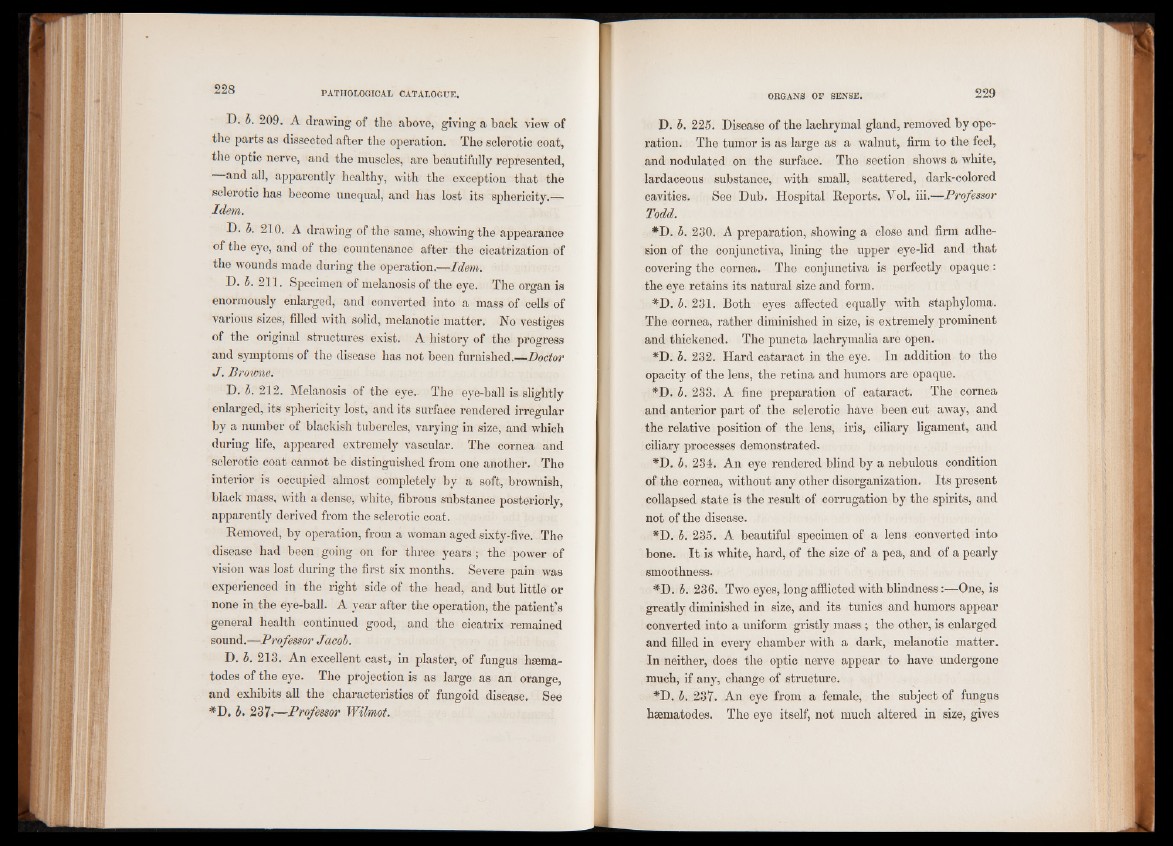
D. b. 209. A drawing of the above, giving a back view of
the parts as dissected after the operation. The sclerotic coat,
the optic nerve, and the muscles, are beautifully represented,
and all, apparently healthy, with the exception that the
sclerotic has become unequal, and has lost its sphericity.—
Idem.
D- 3. 210. A drawing of the same, showing the appearance
of the eye, and of the countenance after the cicatrization of
the wounds made during the operation.—Idem.
D. b. 2 1 1 . Specimen of melanosis of the eye. The organ is
enormously enlarged, and converted into a mass of cells of
various sizes, filled with solid, melanotic matter. No vestiges
of the original structures exist. A history of the progress
and symptoms of the disease has not been furnished.—Doctor
J.B r owne.
D. b. 2 12 . Melanosis of the eye.- The eye-ball is slightly
enlarged, its sphericity lost, and its surface rendered irregular
by a number of blackish tubercles, varying in size, and which
during life, appeared extremely vascular. The cornea and
sclerotic coat cannot be distinguished from one another. The
interior is occupied almost completely by a soft, brownish,
black mass, with a dense, white, fibrous substance posteriorly,
apparently derived from the sclerotic coat.
Removed, by operation, from a woman aged sixty-five. The
disease had been going on for three years ; the power of
vision was lost during the first six months. Severe pain was
experienced in the right side of the head, and but little or
none in the eye-ball. A year after the operation, the patient’s
general health continued good, and the cicatrix remained
sound.—Professor Jacob.
D. b. 213. An excellent cast, in plaster, of fungus hsema-
todes of the eye. The projection is as large as an orange,
and exhibits all the characteristics of fungoid disease. See
#D. b. 237.—Professor Wilmot.
D. b. 225. Disease of the lachrymal gland, removed by operation.
The tumor is as large as a walnut, firm to the feel,
and nodulated on the surface. The section shows a white,
lardaceous substance, with small, scattered, dark-colored
cavities. See Dub. Hospital Reports. Vol. iii.—Professor
Todd.
#D. b. 230. A preparation, showing a close and firm adhesion
of the conjunctiva, lining the upper eye-lid and that
covering the cornea. The conjunctiva is perfectly opaque:
the eye retains its natural size and form.
#D. b. 231. Both eyes affected equally with staphyloma.
The cornea, rather diminished in size, is extremely prominent
and thickened. The puncta lachrymalia are open.
*D. b. 232. Hard cataract in the eye. In addition to the
opacity of the lens, the retina and humors are opaque.
*D. b. 233. A fine preparation of cataract. The cornea
and anterior part of the sclerotic have been cut away, and
the relative position of the lens, iris, ciliary ligament, and
ciliary processes demonstrated.
*D. b. 234. An eye rendered blind by a nebulous condition
of the cornea, without any other disorganization. Its present
collapsed state is the result of corrugation by the spirits, and
not of the disease.
*D. b. 235. A beautiful specimen of a lens converted into
bone. It is white, hard, of the size of a pea, and of a pearly
smoothness.
#D. b. 236. Two eyes, long afflicted with blindness:—One, is
greatly diminished in size, and its tunics and humors appear
converted into a uniform gristly mass ; the other, is enlarged
and filled in every chamber with a dark, melanotic matter.
In neither, does the optic nerve appear to have undergone
much, if any, change of structure.
*D. b. 237. An eye from a female, the subject of fungus
hsematodes. The eye itself, not much altered in size, gives